
Documentation
BK9055 and BK9105
Bus Coupler for Ethernet/IP
2.0.0
2019-04-12
Version:
Date:


Table of contents
BK9055 and BK9105 3Version: 2.0.0
Table of contents
1 Foreword ....................................................................................................................................................5
1.1 Notes on the documentation..............................................................................................................5
1.2 Safety instructions .............................................................................................................................6
1.3 Documentation issue status ..............................................................................................................7
2 Product overview.......................................................................................................................................8
2.1 BK9055 - Introduction........................................................................................................................8
2.2 BK9105 - Introduction........................................................................................................................9
2.3 Technical data .................................................................................................................................10
2.4 The Beckhoff Bus Terminal system.................................................................................................10
2.5 Ethernet ...........................................................................................................................................12
3 Mounting and wiring................................................................................................................................14
3.1 Dimensions......................................................................................................................................14
3.2 Installation on mounting rails ...........................................................................................................15
3.3 Power supply, potential groups .......................................................................................................16
3.4 ATEX - Special conditions (standard temperature range) ...............................................................18
3.5 ATEX - Special conditions (extended temperature range) ..............................................................19
3.6 ATEX Documentation ......................................................................................................................20
4 Parametrization and commissioning.....................................................................................................21
4.1 Start-up behaviour of the Bus Coupler ............................................................................................21
4.2 Parameterization of the Bus Coupler using DIP Switches* .............................................................21
4.3 Network classes ..............................................................................................................................22
4.4 IP address .......................................................................................................................................23
4.4.1 Configuration with KS2000 .............................................................................................. 23
4.4.2 Address Configuration via ARP ....................................................................................... 24
4.4.3 Address configuration via BootP server........................................................................... 25
4.4.4 Setting the address using a DHCP server ....................................................................... 29
4.4.5 Subnet mask.................................................................................................................... 29
4.4.6 Testing the IP address..................................................................................................... 30
4.4.7 Reading the MAC-ID........................................................................................................ 30
4.5 Configuration ...................................................................................................................................31
4.5.1 Mapping ........................................................................................................................... 31
4.5.2 EthernetIP Tag Wizard .................................................................................................... 33
4.5.3 Export to Rockwell ........................................................................................................... 44
5 Error handling and diagnosis.................................................................................................................50
5.1 Diagnostic LEDs ..............................................................................................................................50
6 Appendix ..................................................................................................................................................54
6.1 First Steps........................................................................................................................................54
6.2 First Steps - Example ......................................................................................................................58
6.3 General operating conditions...........................................................................................................64
6.4 Test Standards for Device Testing ..................................................................................................66
6.5 Bibliography.....................................................................................................................................66
6.6 List of Abbreviations ........................................................................................................................66
6.7 Support and Service USA................................................................................................................67

Foreword
BK9055 and BK9105 5Version: 2.0.0
1 Foreword
1.1 Notes on the documentation
Intended audience
This description is only intended for the use of trained specialists in control and automation engineering who
are familiar with the applicable national standards.
It is essential that the documentation and the following notes and explanations are followed when installing
and commissioning these components.
It is the duty of the technical personnel to use the documentation published at the respective time of each
installation and commissioning.
The responsible staff must ensure that the application or use of the products described satisfy all the
requirements for safety, including all the relevant laws, regulations, guidelines and standards.
Disclaimer
The documentation has been prepared with care. The products described are, however, constantly under
development.
We reserve the right to revise and change the documentation at any time and without prior announcement.
No claims for the modification of products that have already been supplied may be made on the basis of the
data, diagrams and descriptions in this documentation.
Trademarks
Beckhoff
®
, TwinCAT
®
, EtherCAT
®
, EtherCATP
®
, SafetyoverEtherCAT
®
, TwinSAFE
®
, XFC
®
and XTS
®
are
registered trademarks of and licensed by Beckhoff Automation GmbH.
Other designations used in this publication may be trademarks whose use by third parties for their own
purposes could violate the rights of the owners.
Patent Pending
The EtherCAT Technology is covered, including but not limited to the following patent applications and
patents: EP1590927, EP1789857, DE102004044764, DE102007017835 with corresponding applications or
registrations in various other countries.
The TwinCAT Technology is covered, including but not limited to the following patent applications and
patents: EP0851348, US6167425 with corresponding applications or registrations in various other countries.
EtherCAT
®
is registered trademark and patented technology, licensed by Beckhoff Automation GmbH,
Germany.
Copyright
© Beckhoff Automation GmbH & Co. KG, Germany.
The reproduction, distribution and utilization of this document as well as the communication of its contents to
others without express authorization are prohibited.
Offenders will be held liable for the payment of damages. All rights reserved in the event of the grant of a
patent, utility model or design.

Foreword
BK9055 and BK91056 Version: 2.0.0
1.2 Safety instructions
Safety regulations
Please note the following safety instructions and explanations!
Product-specific safety instructions can be found on following pages or in the areas mounting, wiring,
commissioning etc.
Exclusion of liability
All the components are supplied in particular hardware and software configurations appropriate for the
application. Modifications to hardware or software configurations other than those described in the
documentation are not permitted, and nullify the liability of Beckhoff Automation GmbH & Co. KG.
Personnel qualification
This description is only intended for trained specialists in control, automation and drive engineering who are
familiar with the applicable national standards.
Description of instructions
In this documentation the following instructions are used.
These instructions must be read carefully and followed without fail!
DANGER
Serious risk of injury!
Failure to follow this safety instruction directly endangers the life and health of persons.
WARNING
Risk of injury!
Failure to follow this safety instruction endangers the life and health of persons.
CAUTION
Personal injuries!
Failure to follow this safety instruction can lead to injuries to persons.
NOTE
Damage to environment/equipment or data loss
Failure to follow this instruction can lead to environmental damage, equipment damage or data loss.
Tip or pointer
This symbol indicates information that contributes to better understanding.

Foreword
BK9055 and BK9105 7Version: 2.0.0
1.3 Documentation issue status
Version Modifications
2.0.0 Migration
Update Technical data
ATEX notes added
Update chapter Addressing via Beckhoff BootP Server
Update chapter Error handling and diagnosis
Update structure
1.3.0 BK9055 added
1.2.3
New: EthernetIP Tag Wizard [}44]
1.2.2
New: Update from the mapping calculator and export to Rockwell software [}44]
1.2.1
Note about data types added to chapters first steps [}54] and mapping calculator [}33]
1.2.0 • configuration chapter updated
• mapping calculator added
1.1.0 internal version
1.0.0 HTML documentation; valid as from firmware B3
Firmware notes
BK9105
Determine which firmware was fitted when the Bus Coupler left the factory by checking the adhesive label
underneath the bus coupler (see the fifth and sixth figures of the production number).
Example:
3200B2020000
The firmware in this example is B2.
In order to update your firmware, you require the KS2000 configuration software and the serial cable
included with that software. You will find the firmware under www.beckhoff.com.
Firmware Description
B5
DIP-Switch Settings [}21]
B3
New: K-Bus Counter [}31]
B2 First release

Product overview
BK9055 and BK91058 Version: 2.0.0
2 Product overview
2.1 BK9055 - Introduction
Fig.1: BK9055
The Compact BK9055 Bus Coupler connects EtherNet/IP with the modular, extendable electronic terminal
blocks. One unit consists of one Bus Coupler, any number from 1to 64 terminals (255 with K-bus extension)
and one end terminal.
The Bus Coupler recognizes the terminals to which it is connected, and performs the assignment of the
inputs and outputs to the words of the process image automatically. The BK9055 Bus Coupler supports
10Mbit/s and 100Mbit/s Ethernet. Connection is through normal RJ45 connectors. The IP address is set on
the DIP switch (offset to a freely selectable start address). In networks with DHCP (a service for the
allocation of the logical IP address to the physical node address [MAC-ID]) the Bus Coupler obtains its IP
address from the DHCP server.
Ethernet/IP is the Industrial Ethernet standard of ODVA (Open DeviceNet Vendor Association). Ethernet/IP
is based on Ethernet TCP/IP and UDP/IP – IP stands for Industrial Protocol. Essentially, the CIP (Common
Industrial Protocol) used in ControlNet and DeviceNet was ported to Ethernet TCP/IP and UDP/IP.
Complex signal processing for analog I/Os, position measurement …
The BK9000 and BK9050 Bus Couplers support the operation of all Bus Terminal types.
The analog and multi-functional Bus Terminals can be adapted to each specific application using the
KS2000 configuration set. Depending on the type, the analog Bus Terminals' registers contain temperature
ranges, gain values and linearization characteristics. With the KS2000, the required parameters can be set
on a PC. The Bus Terminals store settings permanently and in a fail-safe manner.
Optionally, the Bus Terminals can also be controlled by the control system. Via function blocks (FBs), the
programmable logic controller (PLC) or the Industrial PC (IPC) handles configuration of the complete
periphery during the start-up phase. If required, the controller can upload the decentrally created
configuration data in order to centrally manage and store this data. Therefore, new adjustments are not
necessary in the event of replacement of a Bus Terminal. The controller carries out the desired setting
automatically after switching on.

Product overview
BK9055 and BK9105 9Version: 2.0.0
2.2 BK9105 - Introduction
Fig.2: BK9105
The BK9105 Bus Coupler connects EtherNet/IP with the modular, extendable electronic terminal blocks. One
unit consists of one Bus Coupler, any number from 1 to 64 terminals (255 with K-bus extension) and one end
terminal.
The Bus Coupler recognizes the terminals to which it is connected, and performs the assignment of the
inputs and outputs to the words of the process image automatically. The BK9105 Bus Coupler supports
10Mbit/s and 100Mbit/s Ethernet. Connection is through normal RJ 45 connectors. The IP address is set on
the DIP switch (offset to a freely selectable start address). In networks with DHCP (a service for the
allocation of the logical IP address to the physical node address [MAC-ID]) the Bus Coupler obtains its IP
address from the DHCP server.
The BK9105 contains a 3-port switch. Two ports operate external on RJ 45 connectors and can be utilized.
The I/O stations can thus be configured with a line topology, instead of the classic star topology. In many
applications this significantly reduces the wiring effort and the cabling costs. The maximum distance between
two couplers is 100m. Up to 20 BK9105 Bus Couplers are cascadable, so that a maximum line length of
2km can be achieved.
Ethernet/IP is the Industrial Ethernet standard of ODVA (Open DeviceNet Vendor Association). Ethernet/IP
is based on Ethernet TCP/IP and UDP/IP – IP stands for Industrial Protocol. Essentially, the CIP (Common
Industrial Protocol) used in ControlNet and DeviceNet was ported to Ethernet TCP/IP and UDP/IP.
Complex signal processing for analog I/Os, position measurement …
The BK9105 Bus Coupler supports the operation of all Bus Terminal types.
The analog and multi-functional Bus Terminals can be adapted to each specific application using the
KS2000 configuration set. Depending on the type, the analog Bus Terminals' registers contain temperature
ranges, gain values and linearization characteristics. With the KS2000, the required parameters can be set
on a PC. The Bus Terminals store settings permanently and in a fail-safe manner.
Optionally, the Bus Terminals can also be controlled by the control system. Via function blocks (FBs), the
programmable logic controller (PLC) or the Industrial PC (IPC) handle configuration of the complete
periphery during the start-up phase. If required, the controller can upload the decentrally created
configuration data in order to centrally manage and store this data. Therefore, new adjustments are not
necessary in the event of replacement of a Bus Terminal. The controller carries out the desired setting
automatically after switching on.

Product overview
BK9055 and BK910510 Version: 2.0.0
2.3 Technical data
Technical data BK9055 BK9105
Number of Bus Terminals 64 (255 with K-Bus extension) 64
Digital peripheral signals 3,936 Inputs/Outputs
Analog peripheral signals 122 Inputs/Outputs
Protocol EtherNet/IP
Configuration possibility Via the KS2000 configuration software or the controller (TwinCAT)
Maximum number of bytes 492bytes of input and 492bytes of output data
Bus connection 1 x RJ45 2 x RJ45 (2 Port Switch)
Power supply 24V
DC
(-15%/+20%)
Input current 70mA + (total K-Bus current)/4, 500mA max.
Starting current app. 2.5 x continuous current
Recommended fuse ≤ 10A
K-Bus power supply up to 1750mA
Power contact voltage max. 24V
DC
Power contact current load max. 10A
Dielectric strength 500V (power contact / supply voltage / fieldbus)
Weight app. 100g app. 170g
Assembly on 35mm mounting rail according to EN 60715
Permissible ambient temperature
(operation)
0°C ... +55°C -25°C ... +60°C
Permissible ambient temperature
(storage)
-25 °C ... +85°C -40 °C ... +85°C
Permissible relative humidity 95%, no condensation
Vibration / shock resistance conforms to EN60068-2-6/ EN60068-2-27
EMC resistance burst / ESD conforms to EN61000-6-2/ EN61000-6-4
Installation position variable
Protection class IP20
Approvals
CE, UL, ATEX [}18] CE, UL, ATEX [}19], GL
System
System data EtherNet/IP
Number of I/O modules only limited by the IP address space
Number of I/O points depending on the controller
Data transfer medium twisted pair copper cable, 4 x 2, shielded, category 5 (100Mbit/s),
category 3 (10Mbit/s)
Distance between modules 100m
Data transfer rate 10/100Mbit/s
Topology BK9055: star wiring
BK9105: line or star wiring
Cascading up to 20 BK9105 or max. line length 2km
2.4 The Beckhoff Bus Terminal system
Up to 256 Bus Terminals, with 1 to 16I/O channels per signal form
The Bus Terminal system is the universal interface between a fieldbus system and the sensor / actuator
level. A unit consists of a Bus Coupler as the head station, and up to 64 electronic series terminals, the last
one being an end terminal. Up to 255 Bus Terminals can be connected via the K-bus extension. For each

Product overview
BK9055 and BK9105 11Version: 2.0.0
technical signal form, terminals are available with one, two, four or eight I/O channels, which can be mixed
as required. All the terminal types have the same mechanical construction, so that difficulties of planning and
design are minimized. The height and depth match the dimensions of compact terminal boxes.
Decentralised wiring of each I/O level
Fieldbus technology allows more compact forms of controller to be used. The I/O level does not have to be
brought to the controller. The sensors and actuators can be wired decentrally, using minimum cable lengths.
The controller can be installed at any location within the plant.
Industrial PCs as controllers
The use of an Industrial PC as the controller means that the operating and observing element can be
implemented in the controller's hardware. The controller can therefore be located at an operating panel, in a
control room, or at some similar place. The Bus Terminals form the decentralised input/output level of the
controller in the control cabinet and the subsidiary terminal boxes. The power sector of the plant is also
controlled over the bus system in addition to the sensor/actuator level. The Bus Terminal replaces the
conventional series terminal as the wiring level in the control cabinet. The control cabinet can have smaller
dimensions.
Bus Couplers for all usual bus systems
The Beckhoff Bus Terminal system unites the advantages of a bus system with the possibilities of the
compact series terminal. Bus Terminals can be driven within all the usual bus systems, thus reducing the
controller parts count. The Bus Terminals then behave like conventional connections for that bus system. All
the performance features of the particular bus system are supported.
Mounting on standardized mounting rails
The installation is standardized thanks to the simple and space-saving mounting on a standardized mounting
rail (EN60715, 35mm) and the direct wiring of actuators and sensors, without cross connections between
the terminals. The consistent labelling scheme also contributes.
The small physical size and the great flexibility of the Bus Terminal system allow it to be used wherever a
series terminal is also used. Every type of connection, such as analog, digital, serial or the direct connection
of sensors can be implemented.
Modularity
The modular assembly of the terminal strip with Bus Terminals of various functions limits the number of
unused channels to a maximum of one per function. The presence of two channels in one terminal is the
optimum compromise of unused channels and the cost of each channel. The possibility of electrical isolation
through potential feed terminals also helps to keep the number of unused channels low.
Display of the channel state
The integrated LEDs show the state of the channel at a location close to the sensors and actuators.
K-bus
The K-bus is the data path within a terminal strip. The K-bus is led through from the Bus Coupler through all
the terminals via six contacts on the terminals' side walls. The end terminal terminates the K-bus. The user
does not have to learn anything about the function of the K-bus or about the internal workings of the
terminals and the Bus Coupler. Many software tools that can be supplied make project planning,
configuration and operation easy.
Potential feed terminals for isolated groups
The operating voltage is passed on to following terminals via three power contacts. You can divide the
terminal strip into arbitrary isolated groups by means of potential feed terminals. The potential feed terminals
play no part in the control of the terminals, and can be inserted at any locations within the terminal strip.

Product overview
BK9055 and BK910512 Version: 2.0.0
Up to 64Bus Terminals can be used in a terminal block, with optional K-bus extension for up to 256Bus
Terminals. This count does include potential feed terminals, but not the end terminal.
Bus Couplers for various fieldbus systems
Various Bus Couplers can be used to couple the electronic terminal strip quickly and easily to different
fieldbus systems. It is also possible to convert to another fieldbus system at a later time. The Bus Coupler
performs all the monitoring and control tasks that are necessary for operation of the connected Bus
Terminals. The operation and configuration of the Bus Terminals is carried out exclusively by the Bus
Coupler. Nevertheless, the parameters that have been set are stored in each Bus Terminal, and are retained
in the event of voltage drop-out. Fieldbus, K-bus and I/O level are electrically isolated.
If the exchange of data over the fieldbus is prone to errors or fails for a period of time, register contents (such
as counter states) are retained, digital outputs are cleared, and analog outputs take a value that can be
configured for each output when commissioning. The default setting for analog outputs is 0 V or 0 mA. Digital
outputs return in the inactive state. The timeout periods for the Bus Couplers correspond to the usual
settings for the fieldbus system. When converting to a different bus system it is necessary to bear in mind the
need to change the timeout periods if the bus cycle time is longer.
The interfaces
A Bus Coupler has six different methods of connection. These interfaces are designed as plug connectors
and as spring-loaded terminals.
2.5 Ethernet
Ethernet was originally developed by DEC, Intel and XEROX (as the "DIX" standard) for passing data
between office devices. The term nowadays generally refers to the IEEE802.3 CSMA/CD specification,
published in 1985. Because of the high acceptance around the world this technology is available everywhere
and is very economical. This means that it is easy to make connections to existing networks.
There are now a number of quite different transmission media: coaxial cable (10Base5), optical fiber
(10BaseF) or twisted pairs (10BaseT) with screen (STP) or without screen (UTP). Using Ethernet, different
topologies can be built such as ring, line or star.
Ethernet transmits Ethernet packets from a sender to one or more receivers. This transmission takes place
without acknowledgement, and without the repetition of lost packets. To achieve reliable data
communication, there are protocols, such as TCP/IP, that can run on top of Ethernet.
Basic principles
The Internet Protocol (IP)
The internet protocol (IP) forms the basis of this data communication. IP transports data packets from one
device to another; the devices can be in the same network, or in different networks. IP here looks after the
address management (finding and assigning MAC-IDs), segmentation and routing. Like the Ethernet
protocol, IP does not guarantee that the data is transported - data packets can be lost, or their sequence can
be changed.
TCP/IP was developed to provide standardised, reliable data exchange between any numbers of different
networks. TCP/IP was developed to provide standardised, reliable data exchange between any numbers of
different networks. Although the term is often used as if it were a single concept, a number of protocols are
layered together: e.g. IP, TCP, UDP, ARP and ICMP.
Transmission Control Protocol (TCP)
The Transmission Control Protocol (TCP) which runs on top of IP is a connection-oriented transport protocol.
It includes error detection and handling mechanisms. Lost telegrams are repeated.

Product overview
BK9055 and BK9105 13Version: 2.0.0
User Datagram Protocol (UDP)
UDP is connectionless transport protocol. It provides no control mechanism when exchanging data between
sender and receiver. This results in a higher processing speed than, for example, TCP. Checking whether or
not the telegram has arrived must be carried out by the higher-level protocol.
Internet Control Message Protocol (ICMP)
It is used by end devices, to exchange information about the current status of the internet protocol.
Address Resolution Protocol (ARP)
Performs conversion between the IP addresses and MAC addresses.
BootP
The BootP protocol allows the TCP/IP address to be set or altered, by addressing the network device with its
MAC-ID.

Mounting and wiring
BK9055 and BK910514 Version: 2.0.0
3 Mounting and wiring
3.1 Dimensions
The system of the Beckhoff Bus Terminals is characterized by low physical volume and high modularity.
When planning a project it must be assumed that at least one Bus Coupler and a number of Bus Terminals
will be used. The mechanical dimensions of the Bus Couplers are independent of the fieldbus system.
Fig.3: Dimensions
The total width in practical cases is composed of the width of the Bus Coupler, the KL9010 Bus End
Terminal and the width of the bus terminals in use. Depending on function, the Bus Terminals are 12 or
24mm wide. The front wiring increases the total height of 68 mm by about 5 to 10mm, depending on the
wire thickness.
Mechanical data BKxxxx
BCxxxx
BKxx50
BCxx50
BXxxxx LCxxxx
Design form compact terminal housing with signal LED
Material Polyamide
(PA 6.6)
Polyamide
(PA 6.6)
Polycarbonate Polyamide
(PA 6.6)
Dimensions (W x H x D) 49 x 100 x 68mm 44 x 100 x 68mm 81 (BX8000 61) x 100 x
89mm
21 x 100 x 68mm
Mounting on 35 mm C-rail in accordance with EN 60715 with latching
Stackable by Double groove-tongue connection
Labelling Standard terminal block labelling
Vibration/shock
resistance
conforms to EN 60068-2-6 / EN 60068-2-27
EMC immunity/
emission
conforms to EN 61000-6-2 / EN 61000-6-4

Mounting and wiring
BK9055 and BK9105 15Version: 2.0.0
Connection technology BKxxxx
BCxxxx
BKxx50
BCxx50
BXxxxx LCxxxx
Wiring Cage Clamp® spring-loaded system
Connection cross-section 0.08mm² ... 2.5 mm², stranded, solid wire, 28-14 AWG
Fieldbus connection depending on fieldbus spring-loaded terminals
Power contacts 3 spring contacts
Current loading IMAXX 10 A (125 A short circuit)
Rated voltage 24V
DC
3.2 Installation on mounting rails
WARNING
Risk of injury through electric shock and damage to the device!
Bring the Bus Terminals system into a safe, de-energized state before starting mounting, disassembly or
wiring of the Bus Terminals.
Mounting
The Bus Couplers and Bus Terminals are attached to commercially available 35mm mounting rails (DIN rail
according to EN60715) by applying slight pressure:
1. First attach the Fieldbus Coupler to the mounting rail.
2. The Bus Terminals are now attached on the right-hand side of the fieldbus Coupler. Join the compo-
nents with slot and key and push the terminals against the mounting rail, until the lock clicks onto the
mounting rail.
If the terminals are clipped onto the mounting rail first and then pushed together without tongue and
groove, the connection will not be operational! When correctly assembled, no significant gap should
be visible between the housings.
Fixing of mounting rails
The locking mechanism of the terminals and couplers extends to the profile of the mounting rail. At
the installation, the locking mechanism of the components must not come into conflict with the fixing
bolts of the mounting rail. To mount the mounting rails with a height of 7.5mm under the terminals
and couplers, you should use flat mounting connections (e.g. countersunk screws or blind rivets).
Disassembly
Each terminal is secured by a lock on the mounting rail, which must be released for disassembly:
1. Carefully pull the orange-colored lug approximately 1cm out of the terminal to be disassembled, until
it protrudes loosely. The lock with the mounting rail is now released for this terminal, and the terminal
can be pulled from the mounting rail without excessive force.
2. Grasp the released terminal with thumb and index finger simultaneous at the upper and lower grooved
housing surfaces and pull the terminal away from the mounting rail.
Connections within a Bus Terminal block
The electric connections between the Bus Coupler and the Bus Terminals are automatically realized by
joining the components:
• The six spring contacts of the K-Bus/E-Bus deal with the transfer of the data and the supply of the Bus
Terminal electronics.
• The power contacts deal with the supply for the field electronics and thus represent a supply rail within
the Bus Terminal block. The power contacts are supplied via terminals on the Bus Coupler.

Mounting and wiring
BK9055 and BK910516 Version: 2.0.0
Power contacts
During the design of a Bus Terminal block, the pin assignment of the individual Bus Terminals must
be taken account of, since some types (e.g. analog Bus Terminals or digital 4-channel Bus Termi-
nals) do not or not fully loop through the power contacts. Power Feed Terminals (KL91xx, KL92xx
and EL91xx, EL92xx) interrupt the power contacts and thus represent the start of a new supply rail.
PE power contact
The power contact labelled PE can be used as a protective earth. For safety reasons this contact mates first
when plugging together, and can ground short-circuit currents of up to 125A.
NOTE
Risk of damage to the device
Note that, for reasons of electromagnetic compatibility, the PE contacts are capacitatively coupled to the
mounting rail. This may lead to incorrect results during insulation testing or to damage on the terminal (e.g.
disruptive discharge to the PE line during insulation testing of a consumer with a nominal voltage of 230V).
For insulation testing, disconnect the PE supply line at the Bus Coupler or the Power Feed Terminal! In or-
der to decouple further feed points for testing, these Power Feed Terminals can be released and pulled at
least 10mm from the group of terminals.
WARNING
Risk of electric shock!
The PE power contact must not be used for other potentials!
Wiring
Up to eight connections enable the connection of solid or finely stranded cables to the Bus Terminals. The
terminals are implemented in spring force technology. Connect the cables as follows:
1. Open a spring-loaded terminal by slightly pushing with a screwdriver or a rod into the square opening
above the terminal.
2. The wire can now be inserted into the round terminal opening without any force.
3. The terminal closes automatically when the pressure is released, holding the wire safely and perma-
nently.
Shielding
Analog sensors and actuators should always be connected with shielded, pair-wise twisted cables.
3.3 Power supply, potential groups
Power supply for the Bus Coupler
The Bus Couplers require a 24 V
DC
supply for their operation. The connection is made by means of the upper
spring-loaded terminals labelled 24V and 0V. The supply voltage feeds the Bus Coupler electronics and,
over the K-Bus/E-Bus, the Bus Terminals. The power supply for the Bus Coupler electronics and that of the
K-Bus/E-Bus are electrically separated from the potential of the field level.
Power supply for the power contacts
The bottom six connections with spring-loaded terminals can be used to feed the supply for the peripherals.
The spring-loaded terminals are joined in pairs to a power contact. The feed for the power contacts has no
connection to the voltage supply for the Bus Coupler. The design of the feed permits voltages of up to 24V.
The assignment in pairs and the electrical connection between feed terminal contacts allows the connection
wires to be looped through to various terminal points. The current drawn from the power contacts must not
exceed 10A for long periods. The current carrying capacity between two spring-loaded terminals is identical
to that of the connecting wires.

Mounting and wiring
BK9055 and BK9105 17Version: 2.0.0
Power contacts
On the right hand face of the Bus Coupler there are three spring contacts for the power contact connections.
The spring contacts are hidden in slots so that they cannot be accidentally touched. By attaching a Bus
Terminal the blade contacts on the left hand side of the Bus Terminal are connected to the spring contacts.
The tongue and groove guides on the top and bottom of the Bus Coupler and of the Bus Terminals
guarantees that the power contacts mate securely.
Configuration interface (not for BK1250, EK1x00)
The standard Bus Couplers have an RS232 interface at the bottom of the front face. The miniature connector
can be joined to a PC with the aid of a connecting cable and the KS2000 configuration software. The
interface permits the Bus Terminals to be configured, for example adjusting the amplification factors of the
analog channels. The interface can also be used to change the assignments of the bus terminal data to the
process image in the Bus Coupler. The functionality of the configuration interface can also be reached via
the fieldbus using string communication facility.
Electrical isolation
The bus couplers operate by means of three independent potential groups. The supply voltage feeds the K-
Bus/E-Bus electronics in the Bus Coupler and the K-Bus/E-Bus itself in an electrically isolated manner. The
supply voltage is also used to generate the operating voltage for the fieldbus.
Note: All Bus Terminals are electrically isolated from the K-Bus/E-bus. The K-Bus/E-bus is therefore
completely electrically isolated.
Fig.4: Electrical isolation

Mounting and wiring
BK9055 and BK910518 Version: 2.0.0
3.4 ATEX - Special conditions (standard temperature
range)
WARNING
Observe the special conditions for the intended use of Beckhoff fieldbus components with
standard temperature range in potentially explosive areas (directive 94/9/EU)!
• The certified components are to be installed in a suitable housing that guarantees a protection class of at
least IP54 in accordance with EN 60529! The environmental conditions during use are thereby to be
taken into account!
• If the temperatures during rated operation are higher than 70°C at the feed-in points of cables, lines or
pipes, or higher than 80°C at the wire branching points, then cables must be selected whose tempera-
ture data correspond to the actual measured temperature values!
• Observe the permissible ambient temperature range of 0 to 55°C for the use of Beckhoff fieldbus compo-
nents standard temperature range in potentially explosive areas!
• Measures must be taken to protect against the rated operating voltage being exceeded by more than
40% due to short-term interference voltages!
• The individual terminals may only be unplugged or removed from the Bus Terminal system if the supply
voltage has been switched off or if a non-explosive atmosphere is ensured!
• The connections of the certified components may only be connected or disconnected if the supply volt-
age has been switched off or if a non-explosive atmosphere is ensured!
• The fuses of the KL92xx/EL92xx power feed terminals may only be exchanged if the supply voltage has
been switched off or if a non-explosive atmosphere is ensured!
• Address selectors and ID switches may only be adjusted if the supply voltage has been switched off or if
a non-explosive atmosphere is ensured!
Standards
The fundamental health and safety requirements are fulfilled by compliance with the following standards:
• EN 60079-0:2012+A11:2013
• EN 60079-15:2010
Marking
The Beckhoff fieldbus components with standard temperature range certified for potentially explosive areas
bear one of the following markings:
II 3GKEMA 10ATEX0075 X Ex nA IIC T4 GcTa: 0…55°C
or
II 3GKEMA 10ATEX0075 X Ex nC IIC T4 GcTa: 0…55°C

Mounting and wiring
BK9055 and BK9105 19Version: 2.0.0
3.5 ATEX - Special conditions (extended temperature
range)
WARNING
Observe the special conditions for the intended use of Beckhoff fieldbus components with
extended temperature range (ET) in potentially explosive areas (directive 94/9/EU)!
• The certified components are to be installed in a suitable housing that guarantees a protection class of at
least IP54 in accordance with EN 60529! The environmental conditions during use are thereby to be
taken into account!
• If the temperatures during rated operation are higher than 70°C at the feed-in points of cables, lines or
pipes, or higher than 80°C at the wire branching points, then cables must be selected whose tempera-
ture data correspond to the actual measured temperature values!
• Observe the permissible ambient temperature range of -25 to 60°C for the use of Beckhoff fieldbus com-
ponents with extended temperature range (ET) in potentially explosive areas!
• Measures must be taken to protect against the rated operating voltage being exceeded by more than
40% due to short-term interference voltages!
• The individual terminals may only be unplugged or removed from the Bus Terminal system if the supply
voltage has been switched off or if a non-explosive atmosphere is ensured!
• The connections of the certified components may only be connected or disconnected if the supply volt-
age has been switched off or if a non-explosive atmosphere is ensured!
• The fuses of the KL92xx/EL92xx power feed terminals may only be exchanged if the supply voltage has
been switched off or if a non-explosive atmosphere is ensured!
• Address selectors and ID switches may only be adjusted if the supply voltage has been switched off or if
a non-explosive atmosphere is ensured!
Standards
The fundamental health and safety requirements are fulfilled by compliance with the following standards:
• EN 60079-0:2012+A11:2013
• EN 60079-15:2010
Marking
The Beckhoff fieldbus components with extended temperature range (ET) certified for potentially explosive
areas bear the following marking:
II 3GKEMA 10ATEX0075 X Ex nA IIC T4 GcTa: -25…60°C
or
II 3GKEMA 10ATEX0075 X Ex nC IIC T4 GcTa: -25…60°C

Mounting and wiring
BK9055 and BK910520 Version: 2.0.0
3.6 ATEX Documentation
Notes about operation of the Beckhoff terminal systems in potentially explosive ar-
eas (ATEX)
Pay also attention to the continuative documentation
Notes about operation of the Beckhoff terminal systems in potentially explosive areas (ATEX)
that is available in the download area of the Beckhoff homepage http:\\www.beckhoff.com!
Page is loading ...
Page is loading ...
Page is loading ...
Page is loading ...
Page is loading ...
Page is loading ...
Page is loading ...
Page is loading ...
Page is loading ...
Page is loading ...
Page is loading ...
Page is loading ...
Page is loading ...
Page is loading ...
Page is loading ...
Page is loading ...
Page is loading ...
Page is loading ...
Page is loading ...
Page is loading ...
Page is loading ...
Page is loading ...
Page is loading ...
Page is loading ...
Page is loading ...
Page is loading ...
Page is loading ...
Page is loading ...
Page is loading ...
Page is loading ...
Page is loading ...
Page is loading ...
Page is loading ...
Page is loading ...
Page is loading ...
Page is loading ...
Page is loading ...
Page is loading ...
Page is loading ...
Page is loading ...
Page is loading ...
Page is loading ...
Page is loading ...
Page is loading ...
Page is loading ...
Page is loading ...
Page is loading ...
Page is loading ...
Page is loading ...
Page is loading ...
-
 1
1
-
 2
2
-
 3
3
-
 4
4
-
 5
5
-
 6
6
-
 7
7
-
 8
8
-
 9
9
-
 10
10
-
 11
11
-
 12
12
-
 13
13
-
 14
14
-
 15
15
-
 16
16
-
 17
17
-
 18
18
-
 19
19
-
 20
20
-
 21
21
-
 22
22
-
 23
23
-
 24
24
-
 25
25
-
 26
26
-
 27
27
-
 28
28
-
 29
29
-
 30
30
-
 31
31
-
 32
32
-
 33
33
-
 34
34
-
 35
35
-
 36
36
-
 37
37
-
 38
38
-
 39
39
-
 40
40
-
 41
41
-
 42
42
-
 43
43
-
 44
44
-
 45
45
-
 46
46
-
 47
47
-
 48
48
-
 49
49
-
 50
50
-
 51
51
-
 52
52
-
 53
53
-
 54
54
-
 55
55
-
 56
56
-
 57
57
-
 58
58
-
 59
59
-
 60
60
-
 61
61
-
 62
62
-
 63
63
-
 64
64
-
 65
65
-
 66
66
-
 67
67
-
 68
68
-
 69
69
-
 70
70
Beckhoff BK9105 Documentation
- Type
- Documentation
- This manual is also suitable for
Ask a question and I''ll find the answer in the document
Finding information in a document is now easier with AI
Related papers
-
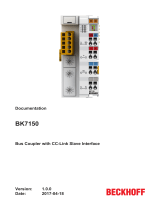 Beckhoff BK7150 Documentation
Beckhoff BK7150 Documentation
-
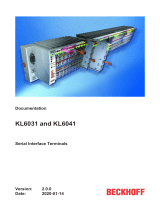 Beckhoff KL6031 Series Documentation
Beckhoff KL6031 Series Documentation
-
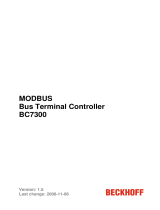 Beckhoff BC7300 User manual
Beckhoff BC7300 User manual
-
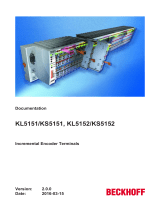 Beckhoff KL5151-0000 Documentation
Beckhoff KL5151-0000 Documentation
-
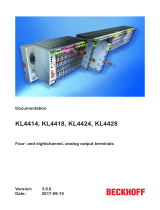 Beckhoff KL4424 Documentation
Beckhoff KL4424 Documentation
-
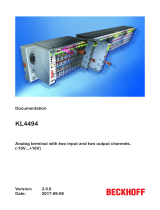 Beckhoff KL4494 User manual
Beckhoff KL4494 User manual
-
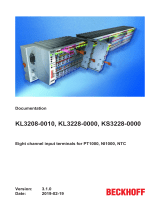 Beckhoff KS3228-0000 Documentation
Beckhoff KS3228-0000 Documentation
-
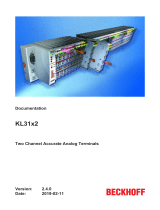 Beckhoff KL3172-0000 Documentation
Beckhoff KL3172-0000 Documentation
-
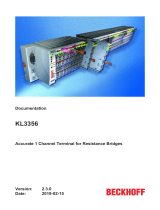 Beckhoff KS3356 Documentation
Beckhoff KS3356 Documentation
-
 Beckhoff KL3222 Documentation
Beckhoff KL3222 Documentation
Other documents
-
Morningstar EMC-1 Quick start guide
-
Pepperl+Fuchs PGV100-F200A-B16-V15 Owner's manual
-
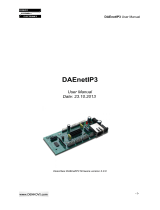 Denkovi DAEnetIP3 User manual
Denkovi DAEnetIP3 User manual
-
Allen-Bradley 193-DNENCATR User manual
-
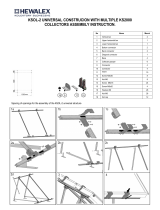 Hewalex KSOL-2 Assembly Instruction
Hewalex KSOL-2 Assembly Instruction
-
Allen-Bradley ControlNet-to-FOUNDATION Fieldbus H1 Installation Instructions Manual
-
Allen-Bradley 1756 ControlLogix Reference guide
-
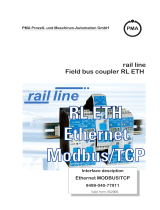 West Control Solutions Rail line MODTCP User manual
West Control Solutions Rail line MODTCP User manual
-
ICP DAS USA EIP-2017 Quick Start
-
ICP DAS USA EIP-2019-S Quick Start



















































































